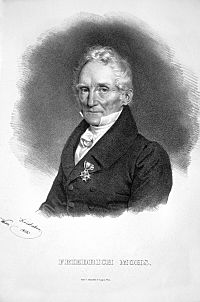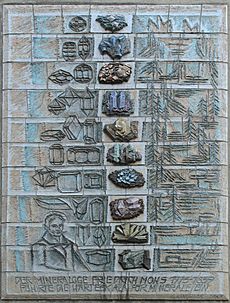Friedrich Mohs facts for kids
Quick facts for kids
Friedrich Mohs
|
|
|---|---|

Friedrich Mohs, 1832
|
|
| Born | 29 January 1773 Gernrode, Holy Roman Empire
|
| Died | 29 September 1839 (aged 66) |
| Alma mater | University of Halle |
| Known for | Mohs scale of mineral hardness |
| Scientific career | |
| Fields | geology, mineralogy |
Carl Friedrich Christian Mohs (born January 29, 1773 – died September 29, 1839) was a German chemist and mineralogist. He is famous for creating the Mohs scale of mineral hardness. This scale helps us measure how hard different minerals are. Mohs also found a way to classify crystals based on their shapes.
Contents
Early Life and Learning
Growing Up in Germany
Friedrich Mohs was born in Gernrode, a town in the Harz mountains of Germany. From a young age, he showed a strong interest in science. He received special lessons at home before going to university.
University Studies
Mohs studied chemistry, mathematics, and physics. He went to the University of Halle. Later, in 1798, he joined the Mining Academy in Freiberg, Saxony. There, he was a student of a famous professor named Abraham Gottlob Werner.
Mohs's Career Journey
Starting in Mines
In 1801, Mohs began working as a foreman at a mine. The next year, he moved to Austria. There, he was hired by a banker, J. F. van der Nüll. Mohs's job was to identify and describe the minerals in the banker's large private collection. He even helped publish a catalog of these minerals.
Work in Graz and Freiberg
In 1812, Mohs moved to Graz. He was hired by Archduke John of Austria. The Archduke had started a new museum and science academy. This academy later split into the Joanneum and the Graz University of Technology. In 1818, Mohs became a professor at the Freiberg Mining Academy. This was the same place where he had been a student.
Professor in Vienna
By 1826, Mohs became a full professor of mineralogy at the University of Vienna. He also became the curator of the Imperial Mineralogical Collection. This collection included the minerals he had described for van der Nüll. Mohs retired in 1835. He then became an imperial counselor for mining. He also helped set up a mining museum in Vienna.
How Mohs Classified Minerals

Mohs started classifying minerals based on their physical features. This was different from the usual way, which focused on their chemical makeup. People like Theophrastus and Pliny the Elder had already compared how hard minerals were in ancient times. They knew that a diamond could scratch quartz, showing diamond was harder.
The Mohs Hardness Scale
This idea became the basis for the Mohs scale of mineral hardness. Mohs gave the hardest mineral, diamond, a value of 10. Softer minerals, like talc, were given a very low value of 1. Other minerals got numbers in between. Their number depended on whether they could scratch another mineral on the scale. For example, gypsum got a value of 2 because it can scratch talc. Calcite got a value of 3 because it can scratch gypsum. Today, minerals are also classified by their chemical properties. But their physical properties are still very useful, especially when studying them in the field.
Personal Life
In 1816, Mohs settled in Vienna. He enjoyed watching balloons there. In 1818, he moved to Freiberg, Saxony. Friedrich Mohs passed away in 1839, at the age of 66. He was on a trip to Agordo, Italy, when he died.
See also
 In Spanish: Friedrich Mohs para niños
In Spanish: Friedrich Mohs para niños

